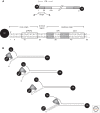Adenovirus DNA replication
- PMID: 23388625
- PMCID: PMC3578361
- DOI: 10.1101/cshperspect.a013003
Adenovirus DNA replication
Abstract
Adenoviruses have attracted much attention as probes to study biological processes such as DNA replication, transcription, splicing, and cellular transformation. More recently these viruses have been used as gene-transfer vectors and oncolytic agents. On the other hand, adenoviruses are notorious pathogens in people with compromised immune functions. This article will briefly summarize the basic replication strategy of adenoviruses and the key proteins involved and will deal with the new developments since 2006. In addition, we will cover the development of antivirals that interfere with human adenovirus (HAdV) replication and the impact of HAdV on human disease.
Figures


Similar articles
-
Suppression of Adenovirus Replication by Cardiotonic Steroids.J Virol. 2017 Jan 18;91(3):e01623-16. doi: 10.1128/JVI.01623-16. Print 2017 Feb 1. J Virol. 2017. PMID: 27881644 Free PMC article.
-
Apobec3A Deamination Functions Are Involved in Antagonizing Efficient Human Adenovirus Replication and Gene Expression.mBio. 2023 Jun 27;14(3):e0347822. doi: 10.1128/mbio.03478-22. Epub 2023 May 8. mBio. 2023. PMID: 37154747 Free PMC article.
-
Engineering the Rapid Adenovirus Production and Amplification (RAPA) Cell Line to Expedite the Generation of Recombinant Adenoviruses.Cell Physiol Biochem. 2017;41(6):2383-2398. doi: 10.1159/000475909. Epub 2017 May 3. Cell Physiol Biochem. 2017. PMID: 28463838
-
Homologous recombination in the replicative cycle of adenovirus and its relationship to DNA replication.Curr Top Microbiol Immunol. 1995;199 ( Pt 2):89-108. doi: 10.1007/978-3-642-79499-5_4. Curr Top Microbiol Immunol. 1995. PMID: 7555071 Review. No abstract available.
-
Adenovirus vectors deleted for genes essential for viral DNA replication.Front Biosci. 2005 May 1;10:1146-55. doi: 10.2741/1607. Front Biosci. 2005. PMID: 15769613 Review.
Cited by
-
Novel viral splicing events and open reading frames revealed by long-read direct RNA sequencing of adenovirus transcripts.PLoS Pathog. 2022 Sep 12;18(9):e1010797. doi: 10.1371/journal.ppat.1010797. eCollection 2022 Sep. PLoS Pathog. 2022. PMID: 36095031 Free PMC article.
-
The adenovirus DNA-binding protein DBP.J Virol. 2024 Feb 20;98(2):e0188523. doi: 10.1128/jvi.01885-23. Epub 2024 Jan 10. J Virol. 2024. PMID: 38197632 Free PMC article. Review.
-
Adenovirus Core Proteins: Structure and Function.Viruses. 2021 Feb 28;13(3):388. doi: 10.3390/v13030388. Viruses. 2021. PMID: 33671079 Free PMC article. Review.
-
Histone Deacetylase Inhibitors Promote Latent Adenovirus Reactivation from Tonsillectomy Specimens.J Virol. 2020 Jun 1;94(12):e00100-20. doi: 10.1128/JVI.00100-20. Print 2020 Jun 1. J Virol. 2020. PMID: 32269118 Free PMC article.
-
Identifying Host Factors Associated with DNA Replicated During Virus Infection.Mol Cell Proteomics. 2017 Dec;16(12):2079-2097. doi: 10.1074/mcp.M117.067116. Epub 2017 Oct 2. Mol Cell Proteomics. 2017. PMID: 28972080 Free PMC article.
References
-
- Abdus Sattar AK, Lin TC, Jones C, Konigsberg WH 1996. Functional consequences and exonuclease kinetic parameters of point mutations in bacteriophage T4 DNA polymerase. Biochemistry 35: 16621–16629 - PubMed
-
- Bebenek A, Dressman HK, Carver GT, Ng S, Petrov V, Yang G, Konigsberg WH, Karam JD, Drake JW 2001. Interacting fidelity defects in the replicative DNA polymerase of bacteriophage RB69. J Biol Chem 276: 10387–10397 - PubMed
-
- Berk AJ 2005. Recent lessons in gene expression, cell cycle control, and cell biology from adenovirus. Oncogene 24: 7673–7685 - PubMed
Publication types
MeSH terms
Substances
LinkOut - more resources
Full Text Sources
Other Literature Sources
